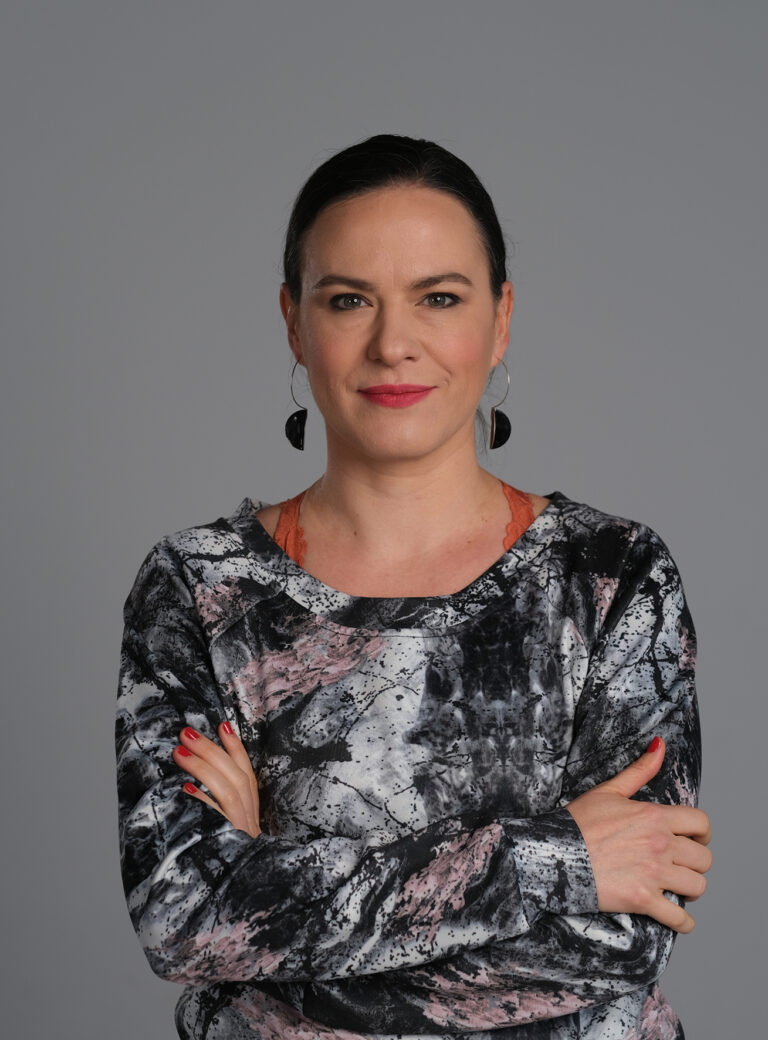Ivana Smiljanić

– born in 1980 in Belgrade. She is a visual and performance artist. She completed her BA and MA studies at the Faculty of Fine Arts in Belgrade, and participated in several study and residential programs. In her work, using various media, she questions the position of her body in different social contexts. She is a winner of the “Dimitrije Bašičević Mangelos” Award (YVAA network) and she represented Serbia at the selection for the Henkel Art Award. She lives in Belgrade / Sofia / Bucharest.
Portrait of Ivana Smiljanić, photo: Stefan Jovanović, courtesy of the artist.
My recent experience of an embryo transfer procedure that wasn’t meant to be: after several months of preparations and three weeks of tracking one menstrual cycle, the day of the embryo transfer arrived. I waited with a full bladder for over two hours for my scheduled appointment at the doctor’s office, and then I was told that the transfer wouldn’t take place because my embryos didn’t survive the cryopreservation. The embryologist was also there, they were showing me pictures of the blastula before and after freezing, and all I could think about was my swollen bladder, whether it would hold, because no one remembered to tell me that I should go to the toilet before that very important, unpleasant and unexpected conversation. It’s so simple. And banal. Yet it didn’t happen. Such experiences, some very important things you don’t know what to do with, which almost can’t be retold – that is what I give value and attention to, and that becomes my work.
My works are preceded by long and careful observation, listening to the world, thinking and taking notes about details, often for years, my notebook is full of them. And over time some of them become a work of art. They are mainly series, one work of art is multiplied, supplemented, changed with each performance or exhibition, and I often use elements from one artwork in a completely different way in the next one.
For example, the performance I DANCE DANCE DANCE123 came to be after my studies, from the jitters and the uncertainty I felt facing my career as an independent artist. I would dance for three hours over the course of three days, to playlists made by other members of the local art scene – artists, curators, art historians, art theorists, the audience.
I wanted to visualize my observations and feelings: how it is both seductive and exhausting being a (young) artist, that what I want and what I do is not enough, because that huge system of art has to recognize and accept me as well.
New invitations followed to take that performance to other countries, so I found new, more universal themes which would, depending on the context, justify dancing again, and over time the performance expanded greatly: I danced to encourage and support women who left violent partners, when the music for the performance was chosen by women with experience of violence4, or to draw the public’s attention to the extent of the burden women carry when they want to become mothers, when the playlist was chosen by women with experience of IVF and hormonal stimulation… The form changes, sometimes it’s a video installation, or the installation is a scenography for a new performance, or I combine video projections with wall drawings. This work is still alive and I hope that I will be able to DANCE DANCE DANCE even when I am 70 or 80 years old for some future important topics for me.
Every performance follows a photo documentation, and some of those photos have become a source for the installations “You’ll Remember Me”5. I have personally experienced what it feels like to be left without human dignity, and how much is needed, with all the support from our loved ones, to regain self-confidence, a normal life, a positive attitude, after an abusive relationship. I kept a “journal of insults” of everything that my abuser said, which hurt like a punch, and when it was over, when I left the abuse and was once again in a safe environment, those journal entries were the only material evidence left of that experience. Free of context, they had a double meaning, they became funny and harmless. “You think someone finds you pretty”, “Nothing here is yours”, “You disgust me”, “Be happy that you’re with me”…
Silhouettes of me dancing were a natural solution for giving form to the text. They also changed over time, they used to be PVC films on the wall, so I was looking for an even less visible appearance, in order to better represent the invisible problem I was talking about. They later became stencils I use to hand-write excerpts from the “Diary of Insults” with a hard graphite pencil on the wall6, or plexiglass plates, which give the impression of some kind of gentle glass forest of figures, that as you walk through you discover some of the text and feel a pain in your gut.
My work is directly connected to my life78 – in themes and tempo and production – and I would say that for years I have been tinkering with it more than really working. Which is ok, I can’t do anything more or differently (now). Apart from the above mentioned, I move a lot, change countries, there is a lot of administration, learning foreign languages, infertility, life according to ovulation, insulin resistance, motherhood, housework, but also anxiety, doubts, loneliness, and everything else that is loud in life but quiet in a CV.
The text is written in collaboration with Mirjana Dragosavljević (2022).
1Reference: Video-performance I DANCE DANCE DANCE, 2007: https://vimeo.com/111867246.2Illustratiion: Ivana Smiljanić: „I DANCE DANCE DANCE“, installation with video projections and wall drawings, Exhibition Sensing Realities, Gallery B-312, Montreal, 2015, photo: Isabelle Guimond, courtesy of the artist.
3Illustration: Ivana Smiljanić, „I DANCE DANCE DANCE“, performance, Exhibition "In the household and in art", the Center for Cultural Decontamination, Belgrade, 2019, photo: Aleksandrija Ajduković, courtesy of the artist.
4Reference: Announcement for the exhibition and one of the performances of „I DANCE DANCE DANCE“, for which the music was chosen by women who survived abusive relationships, Močvara Gallery, 2012, https://www.kontejner.org/en/projekti/galerija-mocvara/izlozbe-u-galeriji-mocvara/ivana-smiljanic-rs-dance-dance-dance.
5Illustration: Ivana Smiljanić, "You’ll Remember Me", installation detail, Exhibition 15 years of the Award "Dimitrije Bašičević Mangelos", Gallery-Legacy of Milica Zorić & Rodoljub Čolaković, Belgrade, 2016, photo: Ivana Smiljanić, courtesy of the artist.
6Reference: Brief overview of the "Invisible" exhibition, CSUCG, 2014, https://www.youtube.com/watch?v=NyqSCoq4DMI.
7Illustration: Ivana Smiljanić, “ANTHURIUM ANDRAEANUM”, video, 2020, photo: Stefan Jovanović, courtesy of the artist.
8Illustration: Ivana Smiljanić, “Inline (in home-making and art)”, photographic installation, Exhibition “Performance, performativity and document”, SULUV Gallery, Novi Sad, 2018, photo: Ivana Smiljanić.
– je rođena 1980. u Beogradu. Vizuelna i performans umetnica. Završila osnovne i magistarske studije na Fakultetu likovnih umetnosti u Beogradu i polaznica više studijskih i rezidencijalnih programa. U svom radu, koristeći različite medije, bavi se preispitivanjem pozicije sopstvenog tela u različitim društvenim kontekstima. Dobitnica Nagrade “Dimitrije Bašičević Mangelos” (mreža YVAA) i predstavljala Srbiju na izboru za Henkel Art Award. Živi u Beogradu / Sofiji / Bukureštu.
Portret Ivane Smiljanić, foto: Stefan Jovanović, ljubaznošću umetnice.
Moje nedavno iskustvo nesuđenog embriotransfera: posle višemesečne pripreme i tri nedelje praćenja jednog menstrualnog ciklusa, došao je dan embriotransfera. Čekala sam s punom bešikom gotovo dva sata od zakazanog termina da me doktorka primi i onda mi je rečeno da transfera neće biti jer moji embrioni nisu preživeli krio-konzervaciju. Prisustvovala je i embriološkinja, pokazivale su mi slike blastula pre i posle zamrzavanja, a ja sam samo razmišljala o svojoj nabrekloj bešici, hoće li izdržati, jer se niko nije setio da mi kaže da pre tog toliko važnog, neprijatnog i neočekivanog razgovora prvo odem do toaleta. Toliko je jednostavno. I banalno. Ali, nije se desilo. Takva iskustva, neke veoma važne stvari s kojima ne znate šta biste, koje gotovo da se ne mogu prepričati – tome dajem zasluženu vrednost i pažnju i to postane moj rad.
Radovima prethodi dugo i pažljivo opažanje, osluškivanje sveta, promišljanje i beleženje nekakvih detalja, često godinama, puna ih je moja beležnica. I vremenom od nekih postane rad. Uglavnom su to serije, jedan rad se umnožava, dopunjava, menja se svakim izvođenjem ili izlaganjem, a i često koristim elemente iz jednog rada na sasvim drugi način u nekom sledećem.
Na primer, performans IGRAM IGRAM IGRAM123 nastao je po završetku studija od treme i neizvesnosti pred budućom samostalnom karijerom umetnice. Tri dana sam po tri sata, bez pauze, igrala uz play-liste po izboru ostalih činilaca lokalne umetničke scene – umetnika i umetnica, kustosa i kustoskinja, istoričara i istoričarki umetnosti, teoretičara i teoretičarki, publike. Htela sam da vizualizujem svoja zapažanja i osećanja: koliko je zavodljivo i istovremeno iscrpljujuće biti (mlada) umetnica, da nije dovoljno šta ja želim i radim, nego da li me taj glomazni sistem umetnosti prepoznaje i prihvata.
Usledili su novi pozivi da izvedem taj performans u drugim zemljama, pa sam pronalazila nove, univerzalnije teme koje bi, u zavisnosti od konteksta, opravdale ponovno igranje i vremenom se rad veoma proširio: igrala sam da ohrabrim i podržim žene koje su ostavile nasilne partnere, kada su muziku za performans birale žene sa iskustvom nasilja4, ili da skrenem pažnju javnosti na razmere tereta koji žene nose u želji da postanu majke, kada su play-listu birale žene sa iskustvom VTO i hormonske stimulacije… Forma se menja, ponekad je to video-instalacija, ili je instalacija scenografija za novi performans, ili video-projekcije kombinujem sa zidnim crtežima. Ovaj rad još uvek živi i nadam se da ću moći da IGRAM IGRAM IGRAM i sa 70 i 80 godina zbog nekih, za mene tada, važnih tema.
Svaki performans prati foto dokumentacija i neke od tih fotografija su postale građa za instalacije “Zapamtićeš ti mene”5. Osetila sam na svojoj koži kako izgleda kad ostaneš bez ljudskog dostojanstva i koliko je puno potrebno, uz svu podršku dragih ljudi, vratiti samopouzdanje, normalan život i osmeh na lice posle iskustva partnerskog odnosa sa nasilnikom. Zapisivala sam u “dnevnik uvreda” sve što je nasilnik govorio, a što je bolelo kao udarac i kad se to završilo, kad sam izašla iz nasilja i ponovo bila u svom sigurnom okruženju, ti zapisi iz “dnevnika uvreda” bili su jedini materijalni trag koji je od tog iskustva ostao. Oslobođeni konteksta, postali su dvosmisleni, smešni i bezopasni. “Misliš da si nekome lepa”, “Ništa ovde nije tvoje”, “Gadiš mi se”, “Budi srećna što si sa mnom”…
Siluete mene koja plešem su se prirodno nametnule da daju formu tekstu. I one su se vremenom menjale, bile su PVC folije na zidu, pa sam tragala za još manje vidljivom pojavnošću, ne bi li što bolje predstavile nevidljivi problem o kome govorim. Postale su šabloni po kojima rukom ispisujem izvode iz “Dnevnika uvreda” tvrdom grafitnom olovkom na zidu6, ili kliritne ploče, koje daju privid nekakve nežne staklene šume figura, kroz koju dok šetate, otkrivate malo-pomalo tekst i temu, i stomak vas boli.
Moj rad je dakle u direktnoj vezi sa mojim životom78 – i tematski i tempom i produkcijski – rekla bih da godinama pre raduckam, nego što radim. I to je u redu, ne mogu (sada) ni više ni drugačije. Osim navedenog, tu su i selidbe i menjanje država, administracija i učenje stranih jezika, sterilitet, život prema ovulaciji, insulinska rezistencija, majčinstvo, domaćinstvo, ali i anksioznost, razna preispitivanja, usamljenost i sve ostalo o čemu život vrišti, a CV ćuti.
Tekst je napisan u saradnji sa Mirjanom Dragosavljević (2022).
1Referenca: Video-performans „I DANCE DANCE DANCE“, 2007, https://vimeo.com/111867246.2Ilustracija: Ivana Smiljanić, „Igram, Igram, Igram“, instalacija sa video-projekcijama i zidnim crtežima, Izložba „Sensing Realities“, Galerija B-312, Montreal, 2015, foto: Isabelle Guimond, ljubaznošću umetnice.
3Ilustracija: Ivana Smiljanić, “IGRAM IGRAM IGRAM”, performans, Izložba "U domaćinstvu i umetnosti", Centar za kulturnu dekontaminaciju, Beograd, 2019, foto: Aleksandrija Ajduković, ljubaznošću umetnice.
4Referenca: Najava za izložbu i jedno od izvođenja performansa “IGRAM IGRAM IGRAM”, za koji su muziku birale žene koje su izašle iz partnerskog nasilja, Galerija Močvara, 2012, https://www.kontejner.org/en/projekti/galerija-mocvara/izlozbe-u-galeriji-mocvara/ivana-smiljanic-rs-dance-dance-dance.
5Ilustracija: Ivana Smiljanić, "Zapamtićeš ti mene", detalj instalacije, Izložba 15 godina Nagrade "Dimitrije Bašičević Mangelos", Galerija-legat Milice Zorić i Rodoljuba Čolakovića, Beograd, 2016, foto: Ivana Smiljanić, ljubaznošću umetnice.
6Referenca: Kratak prikaz izložbe "Nevidljiva", CSUCG, 2014 https://www.youtube.com/watch?v=NyqSCoq4DMI.
7Ilustracija: Ivana Smiljanić, “ANTHURIUM ANDRAEANUM”, video, 2020, foto: Stefan Jovanović, ljubaznošću umetnice.
8Ilustracija: Ivana Smiljanić, „Uređivanje (u domaćinstvu i umetnosti)“, fotografska instalacija, Izložba „Performans, performativnost i dokument“, Galerija SULUV, Novi Sad, 2018, foto: Ivana Smiljanić, ljubaznošću umetnice.



